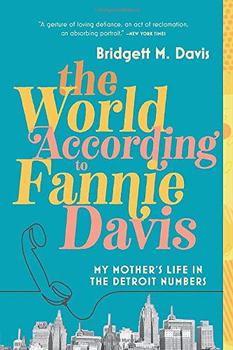Summary | Excerpt | Reviews | Beyond the Book | Read-Alikes | Genres & Themes | Author Bio

My Mother's Life in the Detroit Numbers
by Bridgett M. DavisThis article relates to The World According to Fannie Davis
 In The World According to Fannie Davis: My Mother's Life in the Detroit Numbers, Bridgett M. Davis explains how property ownership was the key determinant in creating opportunity and prosperity across generations of her family. However, historically, there have been hefty barriers to property ownership for people of color in the United States, ranging from racially-motivated violence to discriminatory legislation. The year that Bridgett's grandfather—a working-class tradesman—bought his first piece of land, 26 racial massacres struck Tennessee, later known as the "Red Summer of 1919." Ray Winbush, the director of Fisk University's Race Relations Institute, explains this relationship in basic terms: "If you're looking for stolen black land, just follow the lynching trail." Race, class and property are deeply intertwined, and these issues impact families significantly over decades.
In The World According to Fannie Davis: My Mother's Life in the Detroit Numbers, Bridgett M. Davis explains how property ownership was the key determinant in creating opportunity and prosperity across generations of her family. However, historically, there have been hefty barriers to property ownership for people of color in the United States, ranging from racially-motivated violence to discriminatory legislation. The year that Bridgett's grandfather—a working-class tradesman—bought his first piece of land, 26 racial massacres struck Tennessee, later known as the "Red Summer of 1919." Ray Winbush, the director of Fisk University's Race Relations Institute, explains this relationship in basic terms: "If you're looking for stolen black land, just follow the lynching trail." Race, class and property are deeply intertwined, and these issues impact families significantly over decades.
According to many researchers, land is significant because it contributes to wealth, a long-term measure of resources. Unlike income, something that can be acquired instantly, wealth takes time to accrue. Financial assets are significant because they reduce poverty, increase social mobility, and secure a middle-class status. In his article "Forty Acres and a Gap in Wealth," Henry Louis Gates Jr. describes genealogical research on the family trees of 20 successful African-Americans, ranging from entertainer Oprah Winfrey to astronaut Mae Jemison. He found that 75% of the sample descended from former slaves who owned property by 1920. Despite the small sample, there is a clear relationship between the wealth of property ownership and the life outcomes of African-Americans generations later. Similar research shows that prior familial property ownership separates the black middle class from the black underclass; land ownership correlates with "expanding opportunities for economic betterment."
Other researchers have focused more exclusively on the last couple decades of black home ownership to explain the value of wealth accumulation. In the article "Sub-Prime as a Black Catastrophe," social researchers Melvin L. Oliver and Thomas M. Shapiro focus on how sub-prime loans have disastrously targeted people of color. A sub-prime loan is a type of loan offered at a high rate to those whose credit record doesn't qualify them for the "prime" rate; these loans can be especially difficult for low-income borrowers to pay back. Sub-prime loans are often riddled with high hidden costs, mounting adjustable rates, and prepayment penalties to prevent refinancing. Oliver and Shapiro found that black people receive a disproportionate share of sub-prime loans, which strips them of home-equity gains they have made, and undermines their overall financial situation. Home loans are especially important when considering race and wealth, because as of 2008, home equity was 63% of black average net worth, but only 38.5% of white average net worth, meaning that black wealth is less diversified than white wealth even today.
In 2004, author Ta-Nehisi Coates tackled the question of how and why past discrimination shapes modern-day social problems, publishing a powerful, controversial and award-winning article in The Atlantic titled "The Case for Reparations." In it, he details how 250 years of slavery, 90 years of Jim Crow, 65 years of separate but equal, and 35 years of racist housing policy have compounded to create present-day disparities based on race and class in the United States. His essay is referred to multiple times in The World According to Fannie Davis, as Bridgett M. Davis addresses the role of property ownership and race in her family's legacy. Rare opportunities were presented to her because, even though she is a woman of color with working-class parents, she was born into a family with land wealth. Readers curious about class divisions and structural opportunities will be gripped by Davis' reflections on her "blue-collar black bourgeoisie" background, as she explains how generations of her family have used luck and ingenuity to navigate the challenging path towards upward mobility.
Homeownership by race and ethnicity 1995-2015 from the US Census Bureau
Filed under Society and Politics
![]() This "beyond the book article" relates to The World According to Fannie Davis. It originally ran in February 2019 and has been updated for the
January 2020 paperback edition.
Go to magazine.
This "beyond the book article" relates to The World According to Fannie Davis. It originally ran in February 2019 and has been updated for the
January 2020 paperback edition.
Go to magazine.
Every good journalist has a novel in him - which is an excellent place for it.
Click Here to find out who said this, as well as discovering other famous literary quotes!
Your guide toexceptional books
BookBrowse seeks out and recommends the best in contemporary fiction and nonfiction—books that not only engage and entertain but also deepen our understanding of ourselves and the world around us.